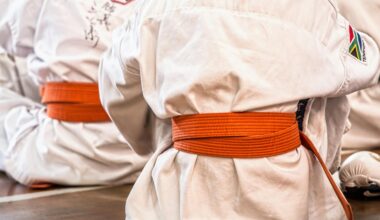Running Cadence: Why It Matters and How to Improve It
Running cadence is the number of steps a runner takes in a minute. This metric is crucial because it significantly affects running efficiency, injury risk, and overall performance. A higher cadence often correlates with better biomechanics and reduces the likelihood of injuries. Runners should aim for a cadence of around 170 to 180 steps per minute, which is generally seen as optimal. Variations exist depending on individual goals and body types, but maintaining a steady cadence can lead to improved form and speed. A proper training plan should focus on cadence adjustment, allowing runners to find their most comfortable rhythm. Monitoring cadence and making gradual changes can enhance endurance during longer runs. Training programs can incorporate exercises aimed at optimizing running cadence. These can include drills such as high-knees, skips, and short sprints. Learning to increase cadence involves both physical and mental aspects of running. Over time, runners can slowly increase their cadence without causing stress. Patience is vital. Hence, runners should track their cadence using various apps or wearable devices for better results.
Understanding Cadence and Its Significance
Understanding cadence is essential for runners who wish to improve their performance and lower injury risks. The importance of being aware of one’s cadence cannot be overstated. A proper cadence facilitates efficient energy expenditure, allowing runners to cover longer distances without excessive fatigue. It encourages a more upright posture, which helps in avoiding common running injuries such as shin splints and joint pain. By adopting a higher cadence, runners may also notice that they hit the ground less hard, mitigating the impacts on their joints. It can be quite beneficial for those already familiar with pace and rhythm to delve deeper into cadence intricacies. Improving cadence focuses not solely on speed but also on techniques for consistency and breathing. As runners work on achieving their desired cadence, they will likely see enhancements not only in the number of steps but also in personal satisfaction and confidence. Strategies include tempo runs and interval training that emphasize quick strides, leading to refinement in overall performance. Incorporating cadence work into recovery sessions can promote better long-term adaptation.
To effectively improve running cadence, start by incorporating specific drills into your regular training routine. These drills can enhance foot speed and efficiency while contributing to overall performance gains over time. Some effective cadence drills may include high-knees, butt kicks, and strides, focusing on quick, light-footed movements. Such drills condition your body to adapt to a higher cadence naturally as you log more miles. A good strategy is to target a punctual increase in cadence rather than attempting a drastic change. As with any important aspect of training, consistency is key to ensuring these practices bear fruit. Gradual adjustments allow the body to adapt adequately to new movement patterns, reducing injury risks linked to sudden changes. Runners may also explore using a metronome or music with appropriate beats per minute, as a simple way to keep their cadence steady and maintain proper rhythm. The right tunes can energize a workout, making the improvement process enjoyable and engaging. Runners can benefit from tracking their cadence, analyzing trends, and adjusting their training accordingly. Embracing this feedback loop fosters continuous improvement.
Incorporating Strength Training for Improvement
In addition to running drills, integrating proper strength-training exercises into your routine can yield significant benefits. Building a strong core and lower body will support your running cadence by improving your overall stability and leg strength. Key exercises should include squats, lunges, and deadlifts, all of which enhance muscular endurance and overall body balance. These exercises not only bolster your muscles but also synchronize movements, leading to a more efficient running form. The combination of strength and running drills yields far-reaching advantages as runner’s work on gaining higher cadence numbers. Ensuring proper recovery is equally important, allowing your muscles to adapt between intense training sessions and ensuring long-term success. Incorporating plyometric exercises is another beneficial method, promoting explosive strength and speed conducive to better running performance. Aim for a cohesive training plan that includes running, strengthwork, and some flexibility exercises for optimal improvement. Yoga or gentle stretching contributes to your overall agility, reducing the risk of injury. Strength training is often overlooked by casual runners. Thus, integrating strength work can help redefine your running style and significantly improve your cadence.
A common misunderstanding is that running faster simply means lengthening your stride. This misconception may lead to potential injuries and reduced efficiency. In fact, increasing cadence is often more about shortening strides, improving rhythm, and enhancing overall comfort. Shorter strides minimize the time spent on the ground, meaning less impact and allowing quicker turnover. As runners become more aware of their stride dynamics, it becomes easier to maintain a sustainable cadence. Likewise, focusing on light steps and proper form enhances your overall biomechanics during running. By doing so, runners can maintain performance over longer distances while minimizing physical strain. Experimenting with different substrates such as track, trail, or pavement may also help tone your cadence technique. Some runners discover that changing environments can unearth potential improvements, allowing them to refine their approach further. Mental strategies also play a role; visualizing the desired cadence can create a subconscious shift toward achieving it. Establishing clear goals regarding cadence can focus your training, encouraging productive sessions. In this manner, results might be enhanced through persistence and tailored practice, guiding the effort towards optimal cadence.
Monitoring Progress for Lasting Improvement
Monitoring progress is indispensable for those dedicated to refining their running cadence. Tools such as running apps, watches, or cadence trackers can provide valuable feedback. Observing your cadence trends enables adjustment to training plans over time. Regular evaluation of progress is critical for making informed decisions affecting your running journey. Identifying patterns allows you to discern what works best for you, whether tight sports watches, fitness trackers, or smartphone apps. Recording your cadence during different workouts can help establish a baseline, leading to discernible improvements in your training. While focusing on goals is vital, allow yourself time and flexibility to achieve your desired cadence without unnecessary pressure. Improvement is not instantaneous; therefore, patience during the adaptation period can help diminish frustrations and set the stage for success. Regularly updating your goals ensures they remain aligned with your current capabilities. Engaging with running communities or forums provides additional support, pushing your progress further and inspiring new techniques. Runners can share experiences and insights. This collaborative approach fosters a sense of belonging within the running community and keeps motivation high throughout the improvement process.
The journey of improving running cadence ultimately hinges on individual commitment and consistency throughout the training period. As runners identify their needs, preferences, and physical capabilities, they can craft a personal training plan that promotes an optimal cadence. Implementing quality over quantity is essential: rather than focusing solely on increasing speed, emphasize maintaining an effective cadence throughout runs. By harmonizing stride, form, and efficiency, one can set the foundation for consistent performance improvement without unnecessary strain. Flexibility in training – allowing adjustments based on daily conditions – can sustain motivation and foster a sense of enjoyment within this pursuit. Explore new trails, join local running clubs, and expand your horizons. This social aspect adds layers of fun while refining technique and cadence together with fellow enthusiasts. Remember that improvement is a gradual process; it’s about building a sustainable routine that melds training, recovery, and goal-setting. Celebrate small victories as they come along the way, aiding emotional resilience. Stride by stride, runners can enhance their cadence and overall effectiveness, enriching every mile they log while cultivating a lasting love for the sport.


